The WSL is back, after a two week break, and the game everyone wanted to see was the clash of the defending champions and one of the teams hoping to wrestle their title off them. Chelsea Women and Manchester United Women as a game gave us some good moments, and was full of action, but there were also areas where we felt disappointed by the display. In this tactical analysis, we will look at the tactics that Chelsea used to counter Manchester United’s preferred way of playing, as well as the mistakes the visitors made in attack and defence, and the changes Casey Stoney made in the second half.
Lineups

Chelsea Women made four changes from the side that beat Reading Women last time out, with manager Emma Hayes looking to rotate her team to keep players fresh. Defender Hannah Blundell, Wales midfielder Sophie Ingle, who had played in defence in that game, midfielder Guro Reiten and former Liverpool Women winger Niamh Charles all dropped to the bench. In came Reiten’s fellow Norway international Maren Mjelde at right-back, whilst captain and Sweden defender Magdalena Eriksson returned at centre-back. In midfield, Scotland international Erin Cuthbert moved to the wing, with South Korea international Ji So-yun coming into the holding midfield area, and Denmark star Pernille Harder also started, playing behind Australia striker Sam Kerr.
Manchester United manager Casey Stoney, meanwhile, made three alterations of her own. Captain Katie Zelem and strikers Jessica Sigsworth and Tobin Heath moved to the bench, with Heath there for show rather than for playing, after picking up a small injury. Into the team came Hayley Ladd, who partnered Netherlands international Jackie Groenen in the midfield, whilst Heath’s fellow USA star Christen Press was handed the centre forward role, and Scotland forward Kirsty Hanson started on the right wing.
Chelsea Women’s transitional play
Chelsea Women like to set up using a diamond system to dominate the midfield, which then allows them to build attacks from there. Their defence is protected by the player at the base of the diamond, whilst the other players get forward to offer passing options in good attacking positions. However, in this game, we saw something different happen.
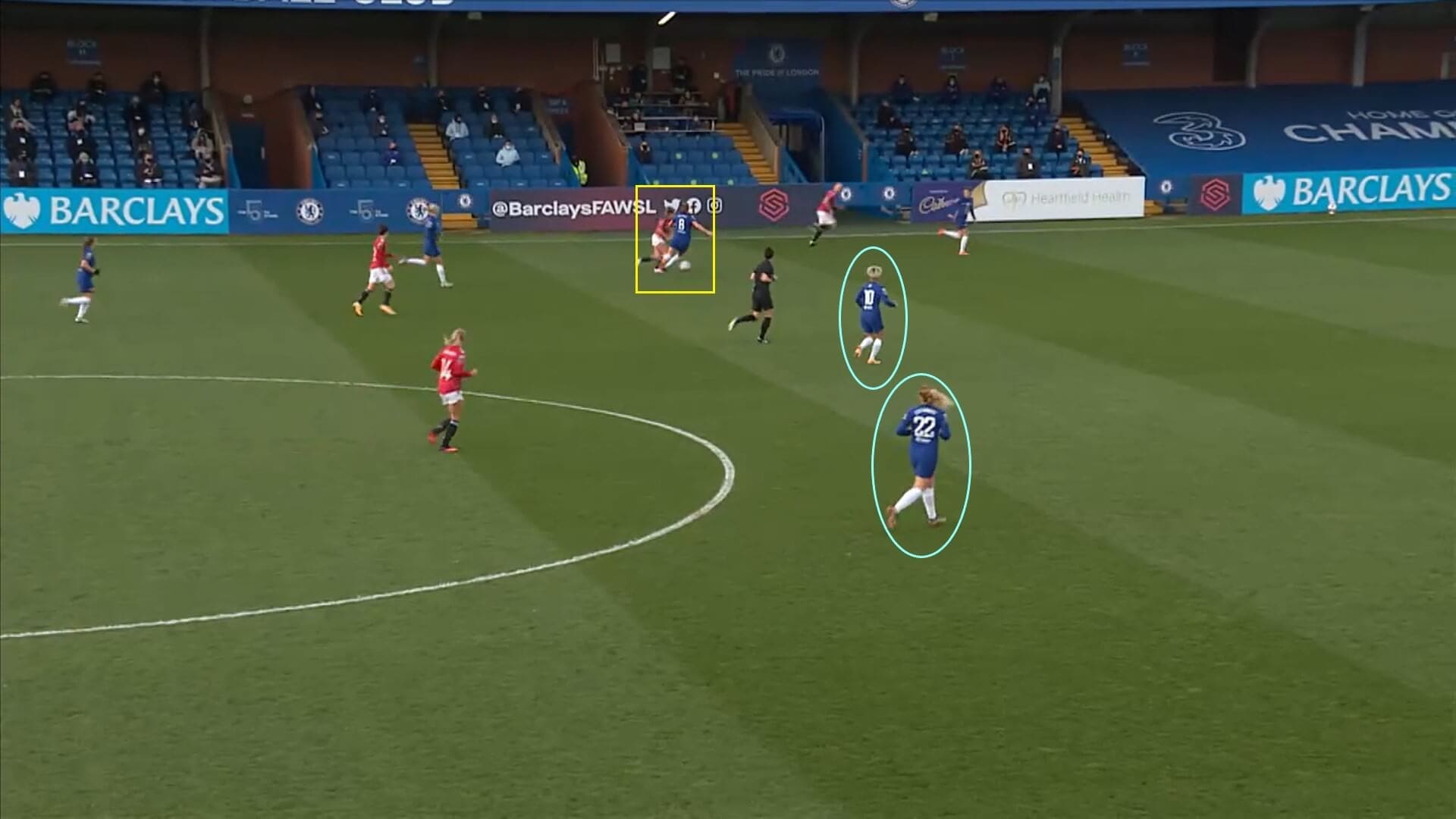
Ji So-yun and Erin Cuthbert are both attack-minded players, and like to operate in the final third. However, both were asked to move between defence and attack against Manchester United Women, and that is what the image above is showing. In transitions, this gave Chelsea their usual attacking threat, but also more bodies in defence.
The reason for this was that Manchester United have a strong attack, usually playing with three or four players in the final third. Therefore, to stop the away side having too much space to operate in, Chelsea’s midfielders tracked back to help out the defence, preventing Manchester United from playing with their usual freedom. This was a key reason for Chelsea’s eventual win.
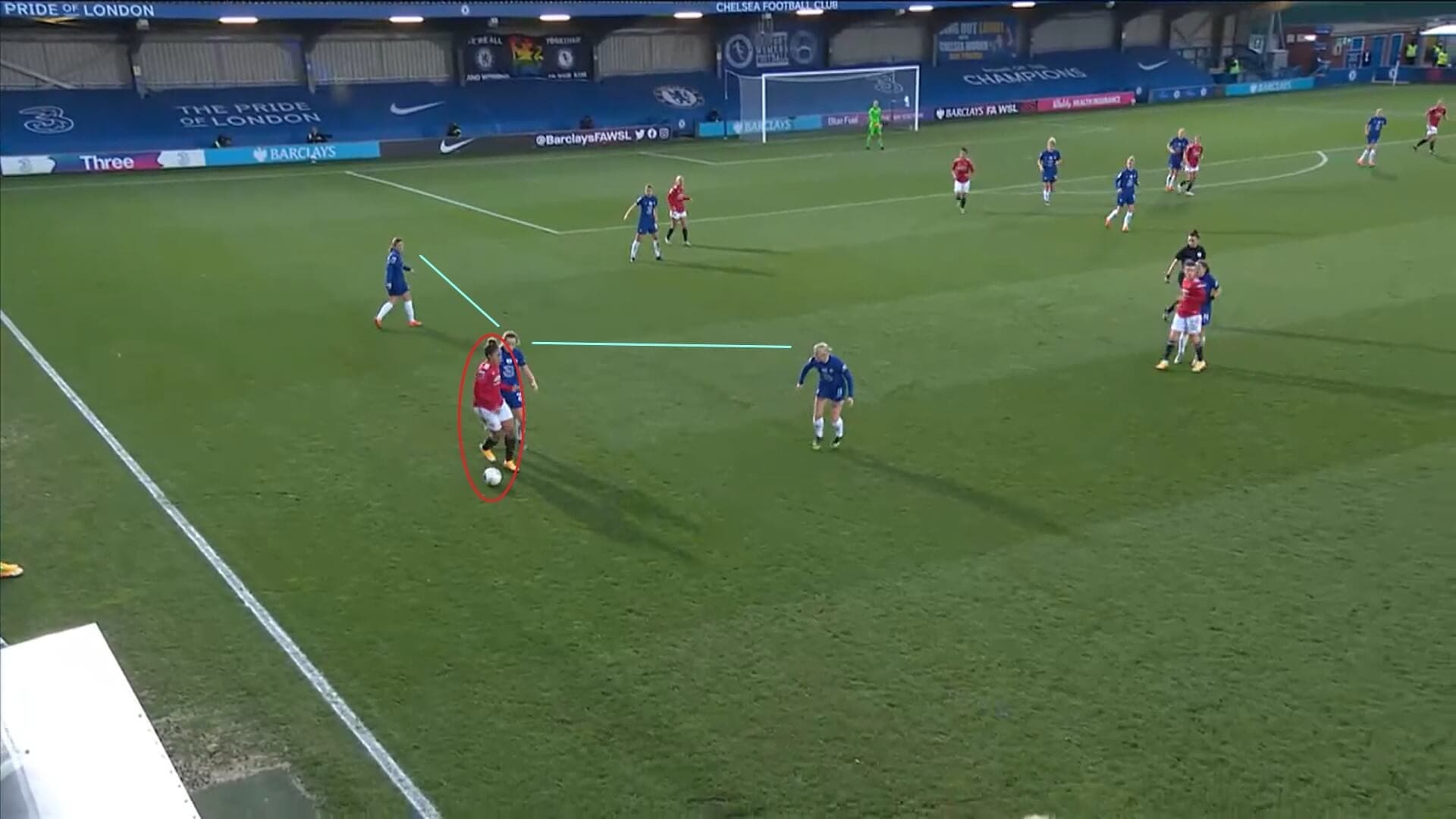
Here, we can see how this helped their defence. Chelsea looked to hunt in packs in their own third, cutting down Manchester United’s options with the ball. We can see how there are three Chelsea players closing it down here, giving Lauren James little option than to play the ball backwards, because the central players can’t be found now. Therefore, this is why Chelsea’s midfielders got back to increase their numbers when Manchester United were on the attack, and how it helped to stop the visitors creating spaces and playing balls in behind Chelsea’s defence.
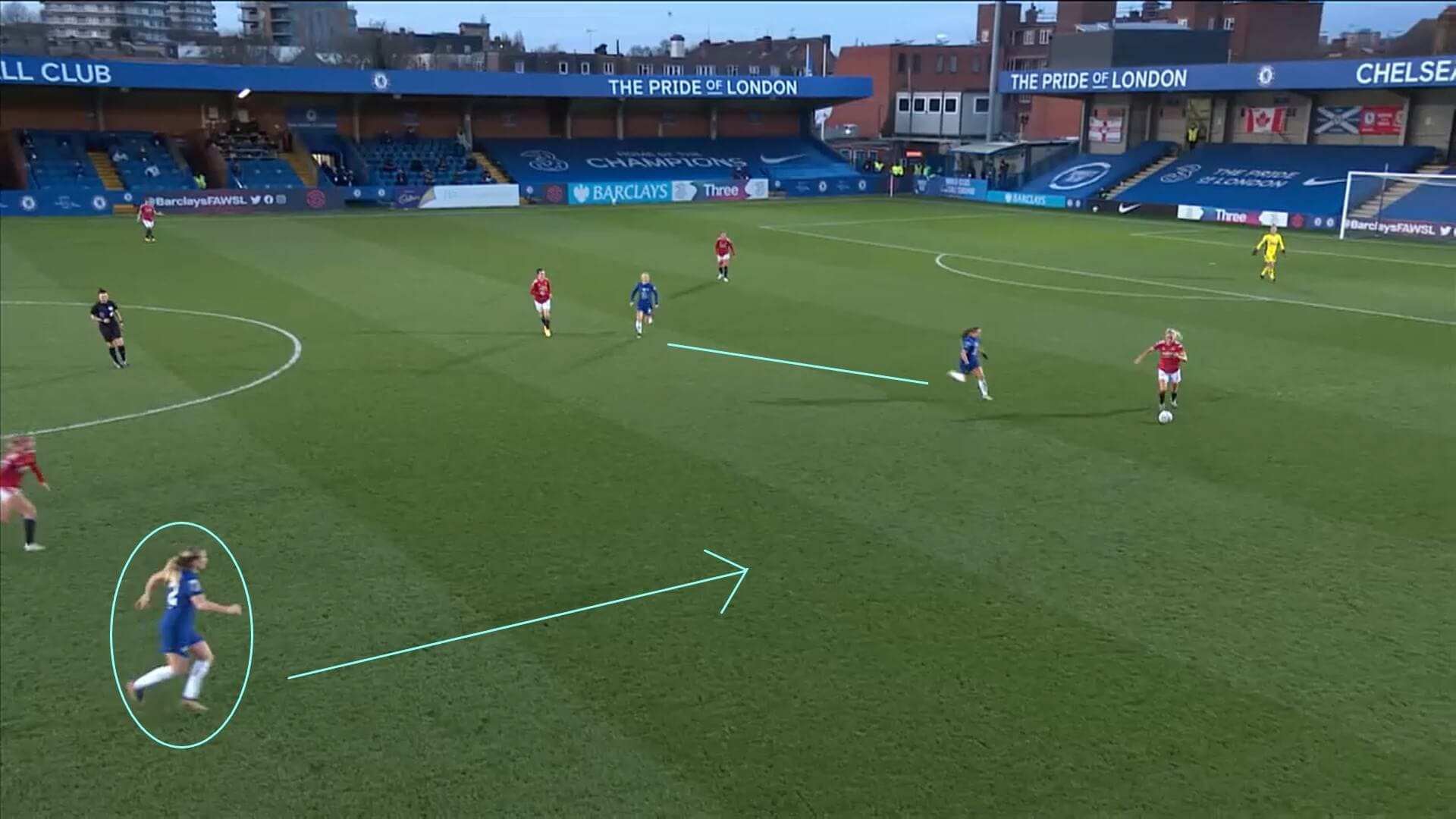
When Chelsea had the ball, they looked to get those midfield players forward, supporting the attack. The home side have formed an attacking line at the top of the pitch, as shown by the blue line, and Cuthbert has come forward to join them at speed. The Scotland international is a quick player, and this is why she is so important for Emma Hayes’ team. She is normally a substitute for them, but the fact that she has started the last few games shows that her pace unlocks defences, and, in this case, helps in the transition from defence to attack and back to defence.
This section has demonstrated how Chelsea had a clear plan for moving the ball from defensive to attacking scenarios. By doing so, they kept Manchester United largely under control, giving them no space to play their usual free-flowing football, but also then having the natural pace in midfield to get forward and support the attack. Emma Hayes hailed her side’s performance as “a team effort”, and we have seen from these images how everyone played their part in getting the win.
Manchester United Women’s defence
However, if we now turn our attention to Manchester United Women, we will see how they contributed to their own downfall. Their defence lacked composure at times, and made mistakes that gave Chelsea Women control of the game.

Here, we can see how Chelsea looked to force gaps in between Manchester United’s defenders. They used a 4-2-3-1 formation in this game, but pushed their wider players forward to support Sam Kerr as much as possible, as seen here. The wingers then took up very wide positions, looking to stretch the Manchester United defenders apart, creating space for Kerr to then get through and behind, enabling her to shoot at goal. This tactic did work, to an extent, but what Chelsea were missing was a killer touch from Kerr, who missed several good chances to score in this game. Had she taken those chances, Chelsea would have been out of sight by half time, which shows you how many opportunities they had.
However, whilst this was not a mistake by Manchester United, the theme of giving Chelsea too much space in their third was a recurring one, and the image below shows this happening.
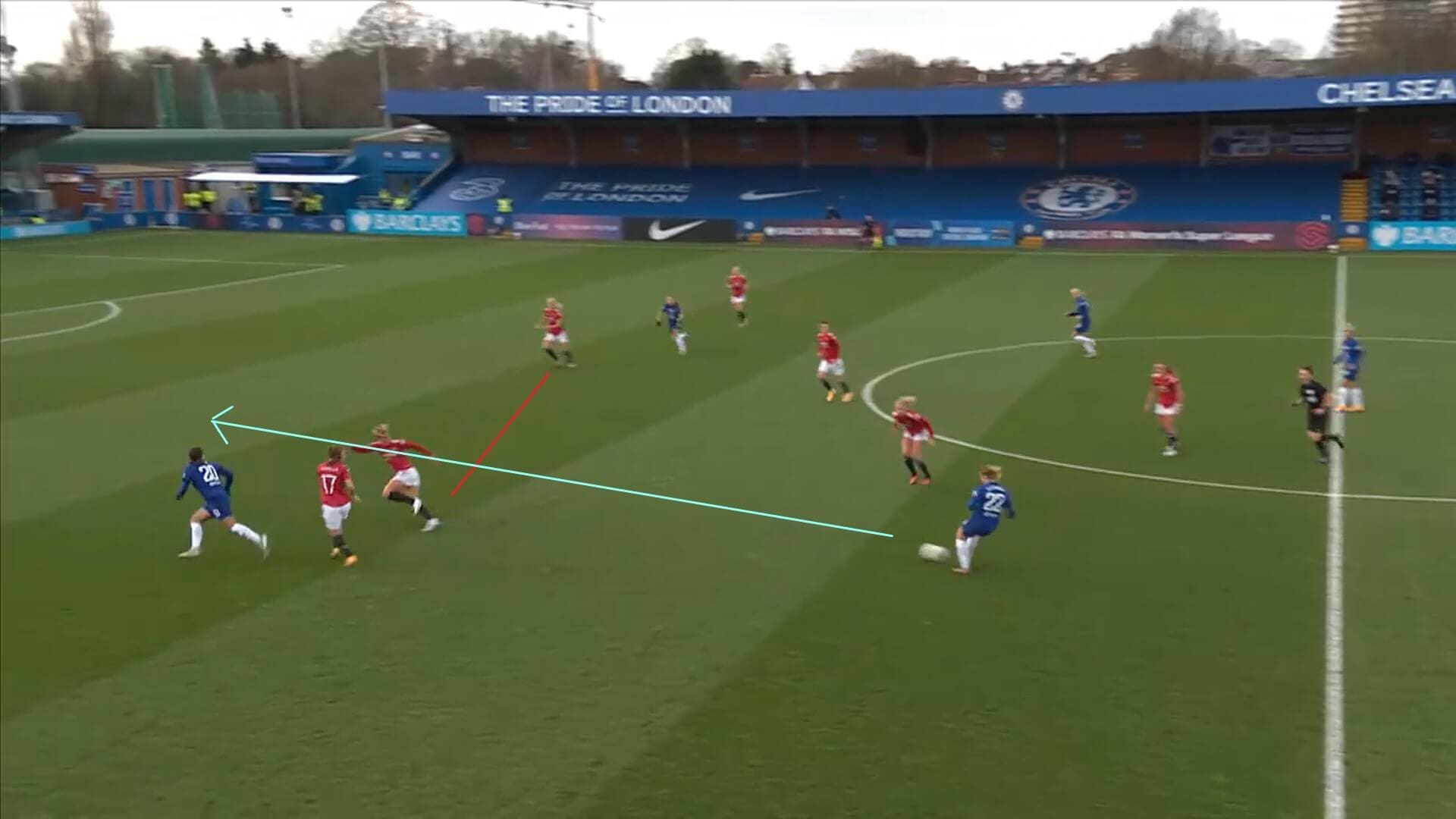
Here, there is an enormous gap in the middle of the defence, as shown by the red line. This has given Chelsea the opportunity to play the ball through with ease, accessing the space behind, giving Kerr constant opportunities to score. This was only one example of this, but it did happen many times in the first half in particular. There was a lack of pressure from Manchester United as well, with Chelsea often playing one-twos to set up these situations, and that again shows how Manchester United were their own worst enemies at times in this match.
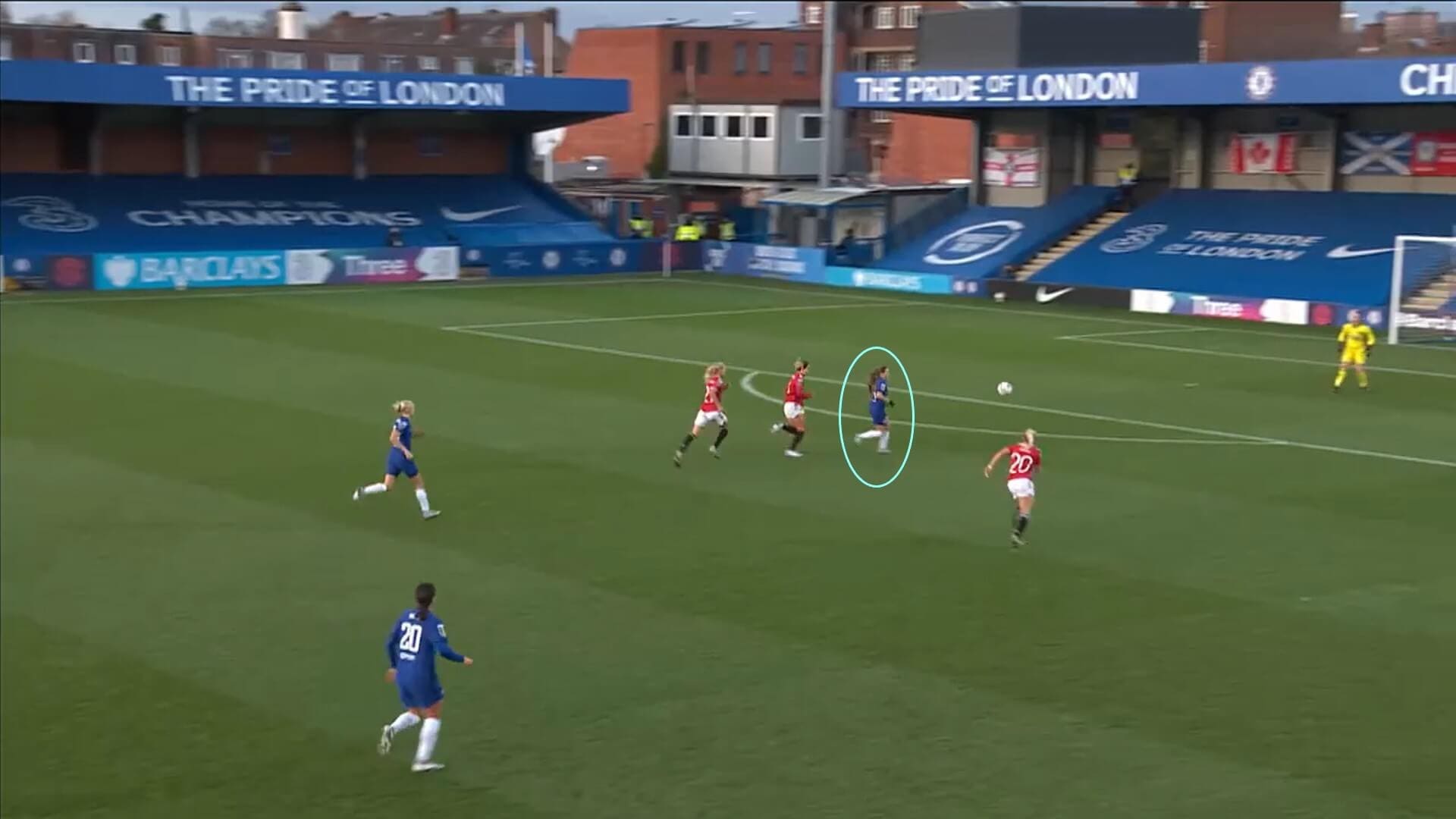
Things didn’t improve much in the second half, either. Manchester United’s defensive tactics are to play with a high back line, leaving space open behind them; this is something we have seen often from them this season. However, Chelsea saw this, and looked to move the ball into the attacking third as quickly as possible whenever they had it, often with a long ball.
That is what has happened here, with Fran Kirby, who is in really good form at the moment, meeting the ball and finding the space behind to score the winning goal. Defender Millie Turner let the ball bounce, which was a crucial error, and one which led to the ball getting away from her and into Kirby’s path. Therefore, this is another defensive mistake that led to an opportunity for Chelsea; this time, it led to the winning goal.
This section has shown how Manchester United’s defensive performance was full of errors, meaning that Chelsea had easy access to the space behind them. By making these mistakes, and by staying with their high back line tactics, Chelsea were able to dominate their opponents’ third, and this was another key reason for their eventual victory. Casey Stoney said afterwards that her side were “fortunate” to go in at half time only one goal down, and we have shown already how Chelsea could have scored more than they did.
Manchester United Women’s attack
Manchester United Women’s attack looked lacklustre at times, which was down to the players they had in the team. Whilst all three of Kirsty Hanson, Christen Press and Leah Galton are excellent players, all possessing pace and the skill to trouble opposing defences, they lacked a co-ordinated approach at times in the final third.
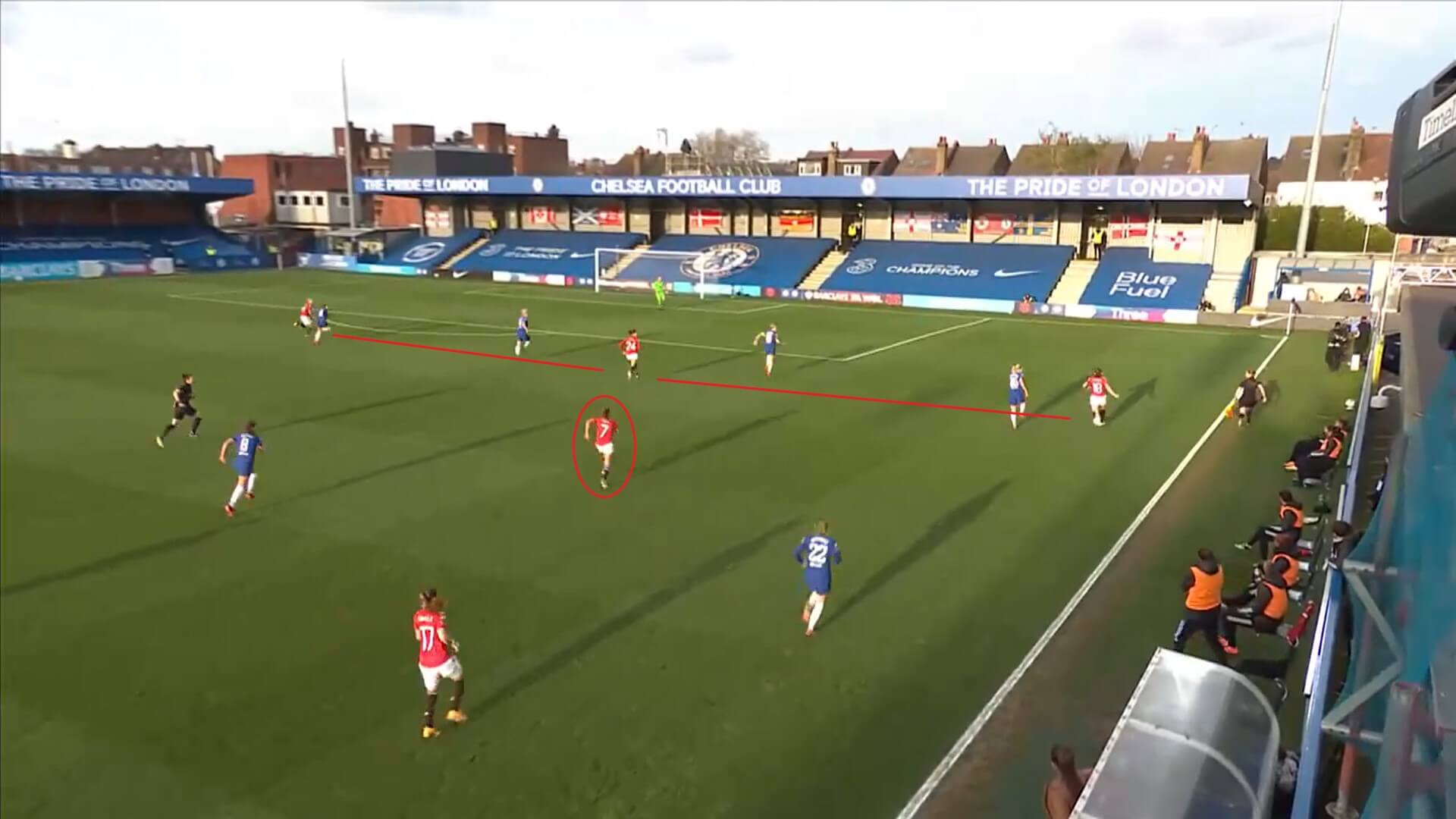
This image shows the fundamentals of how Casey Stoney sets her team up to play in attack. There is a front three, as shown here, and Ella Toone takes up a position just behind those attackers, playing the role of creator, getting balls into spaces where Manchester United can threaten and create chances. With this four-player attack, they can move the ball around quickly, and often get it behind defences before they know it’s there.
As we can see here, Manchester United wanted to use this against Chelsea, looking to get between the defensive and midfield lines as much as possible, putting pressure on Chelsea’s back line. Like Chelsea, Manchester United are stretching the play out, looking to create gaps in between for Christen Press, as the central attacker, to get through and shoot at goal.

However, it was more often the case in this game that Manchester United had just two players at the top, or even just one. Here, Hanson has moved up to join Press in a front two, but there are no teammates behind or around them. Therefore, Chelsea can now play the ball over the top or around them, meaning that the attack is ineffective.
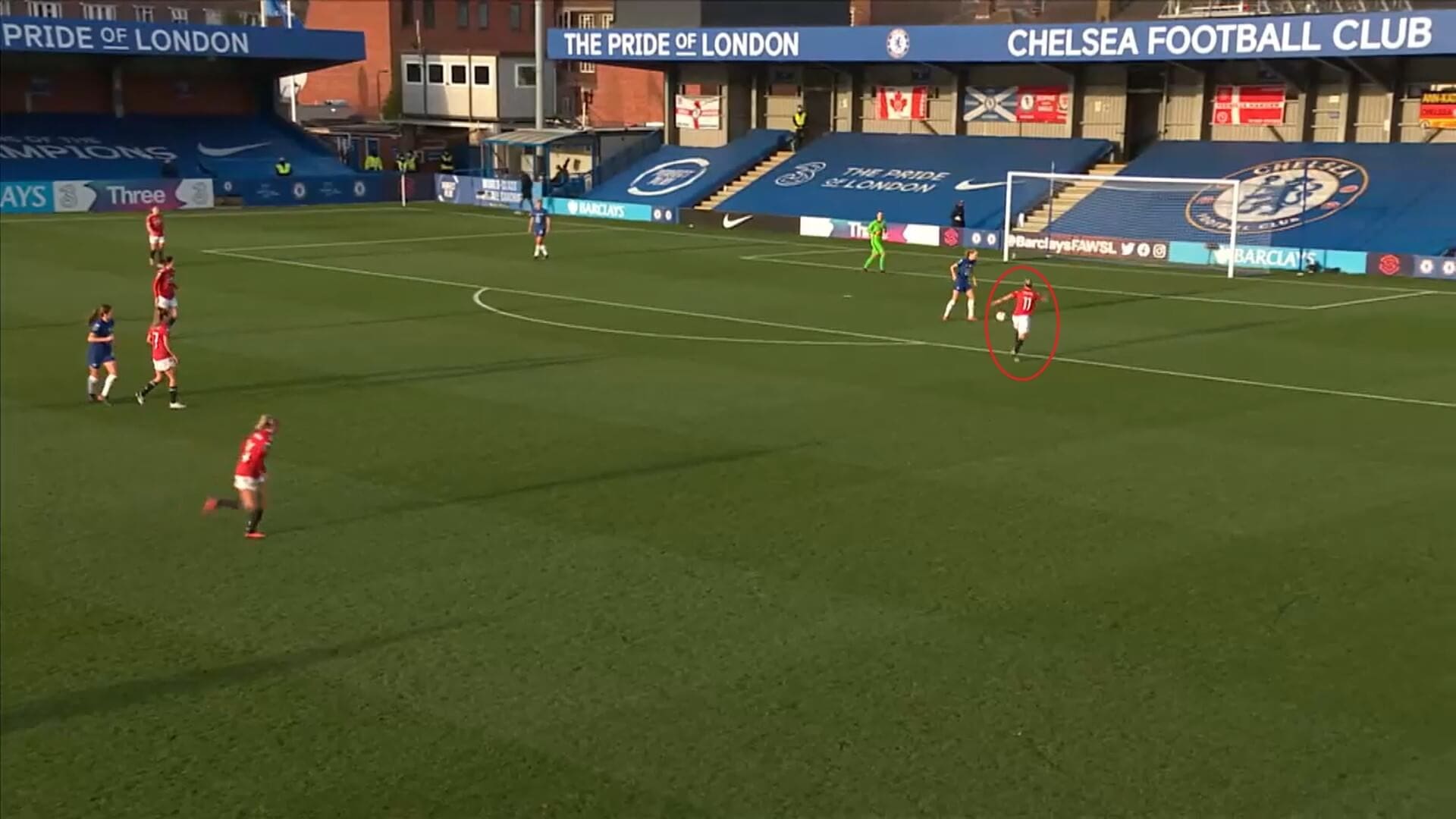
There was also a general lack of energy in Manchester United’s game, as is evident in this image. As we have shown already, they like to play with a front three, positioned across the pitch, as wide as possible. However, only Leah Galton has shown a desire to put pressure on Chelsea goalkeeper Ann-Katrin Berger here, whilst the rest of her teammates are standing back, outside the box. Galton was also chasing back to help her team out defensively, getting in the way of attempted crosses and balls into the box, and her frustration and attempts to increase her teammates’ desire and energy levels was clear to see.
Against Chelsea, teams must expect a tough game, and need to run around a lot to stop them dominating the game, but the errors in this performance, as well as this lack of energy, meant that this wasn’t possible for Manchester United.
Christen Press v Lauren James
If we pick out one area of Manchester United Women’s performance that highlighted their problems, the centre forward area demonstrates them well.
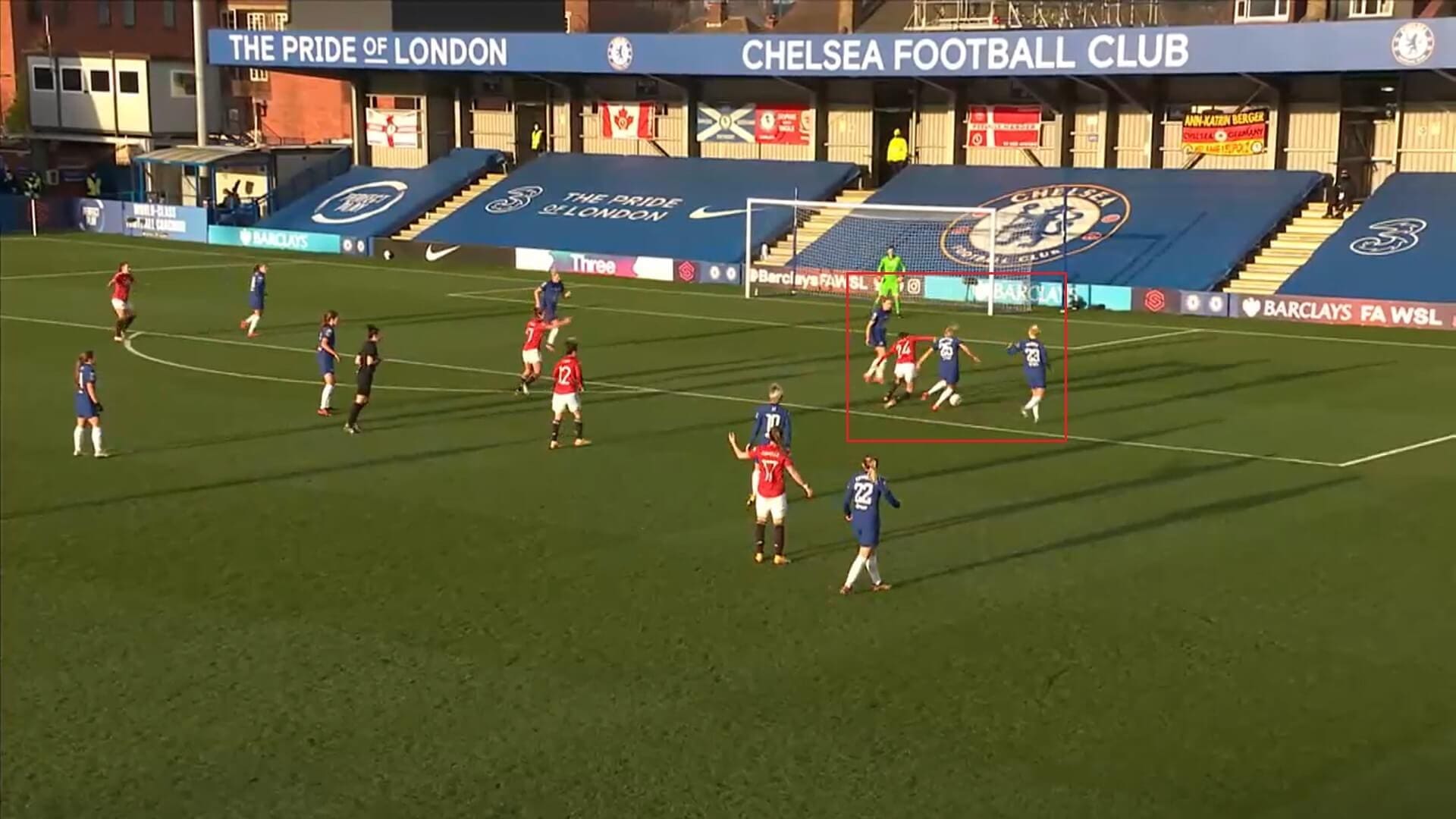
Here, we can see how Christen Press has the ball in Chelsea Women’s box. However, this is not her normal or preferred position. This season, Casey Stoney has played all three of her new forwards, Tobin Heath, Press and Alessia Russo together, with Heath and Press on the wings, and Russo as the central striker. This allows Press and Heath to create chances and stretch the play as required. Here, Press got into areas at times, but was unable to create too many problems, making it easy for Chelsea to surround and win the ball off her, as is happening here. Most of the time, she didn’t even manage to find the spaces she needed to, and that was a big reason for Manchester United’s overall lack of threat in the first half.
However, we can also see how Press doesn’t have much support from her teammates, who are all outside the box, almost the same as with Leah Galton earlier. This means that the USA forward has no viable passing options to continue the attack, because any ball backwards from her current position would give Chelsea the opportunity to close ranks and block any potential shot at goal.
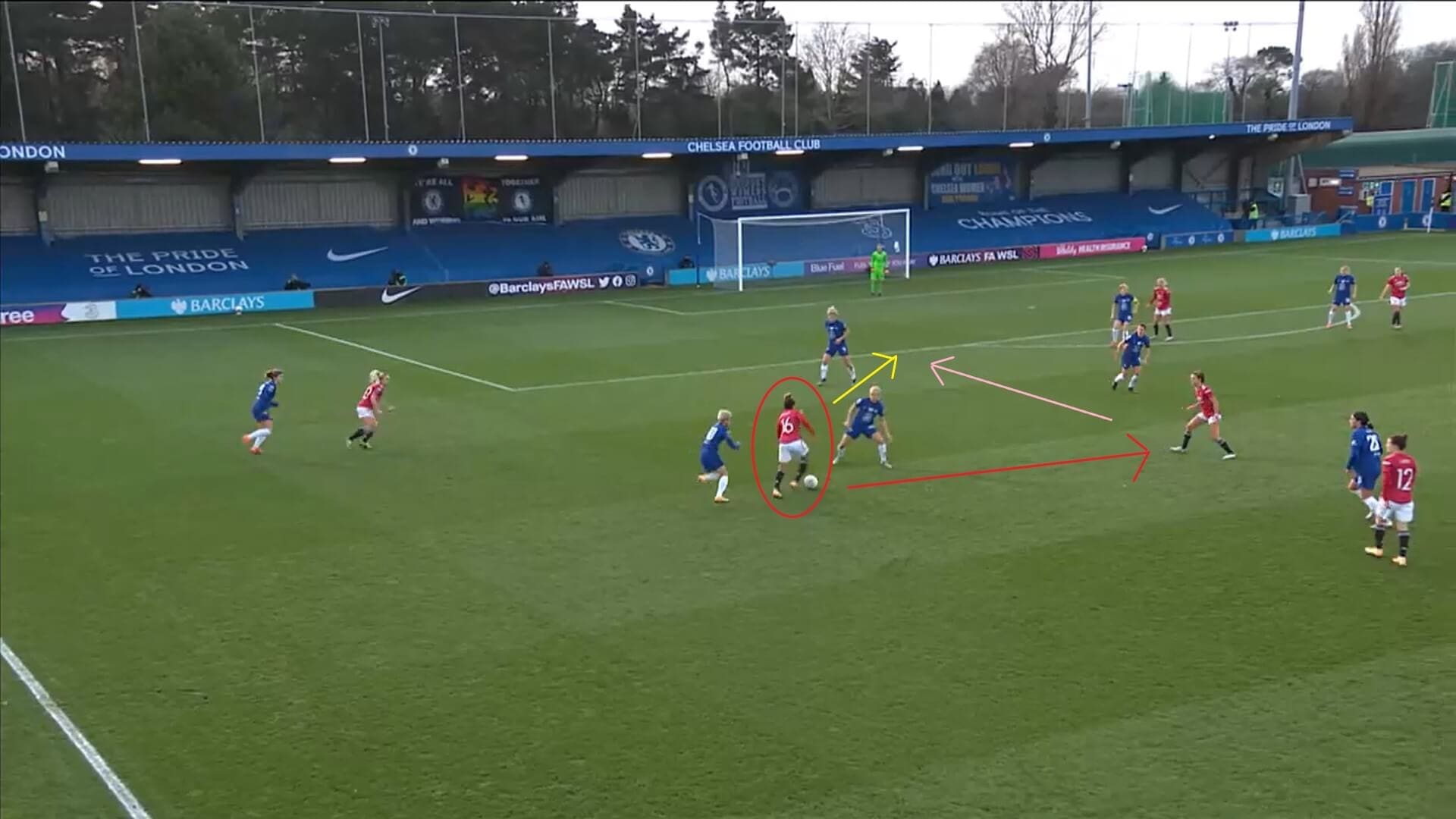
However, relatively early in the second half, Casey Stoney took Press off, putting Lauren James on in her place. James, younger sister of Chelsea men’s defender Reece, is a quick, direct player, capable of playing anywhere in attack. Immediately, Manchester United were causing more problems, offering more of a threat. In this image, we can see how she plays a one-two with Ella Toone, again showing Toone’s role as the creator in the team, and scores the equalising goal. The arrows show how James gets among the Chelsea defenders, and that is where the home side find it harder to defend. Therefore, we can see instantly the difference that James made when coming on, combining the play much more and creating plenty of problems for the defence.
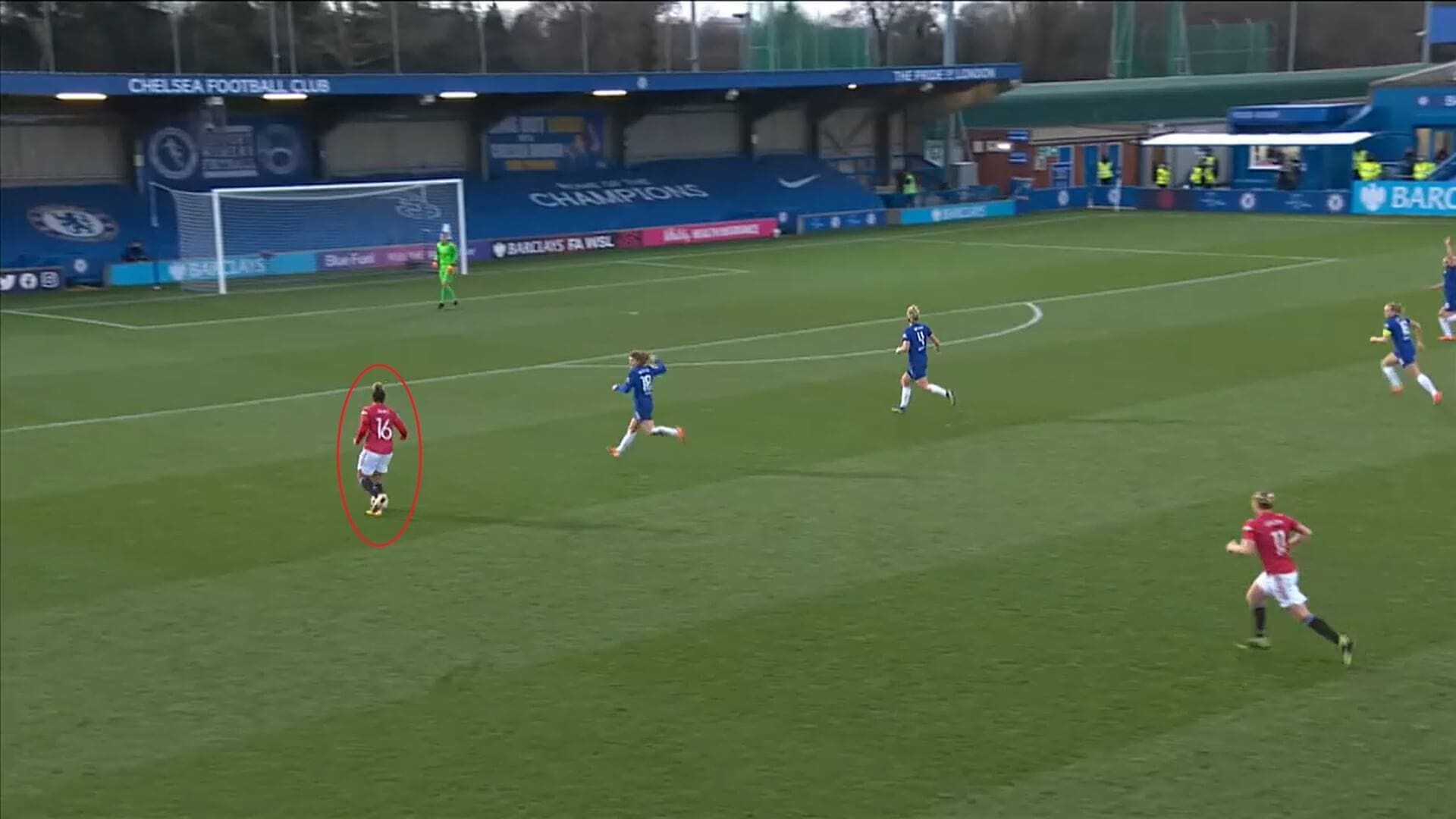
This is another example of James asking questions of the Chelsea defence. We can see how she has the ball outside the defenders, and, from here, she can choose to dribble towards the goal line or cut inside and shoot at goal. On the flip side, Press wasn’t able to find these spaces, and that was the difference. The home side struggled to contain James when she came on, and she certainly showed that she would have been the better option to start at the heart of the attack than Press. We will never know if things would have been different in the first half with James playing, but she definitely injected the energy and directness that had been missing up to that point for her team.
Conclusion
In conclusion, this much-anticipated match-up between two of the top teams in the WSL was a highly-contested game, but one which showed why Chelsea Women are the defending champions, and their ability to adapt their tactics and structure to suit any situation. Our analysis has also shown that, whilst there is no doubt that Manchester United Women are a top team in the league, they lack the same adaptability, as shown by the fact that they played a high back line in this game, despite Chelsea having the players to get in behind them. If they want to make the step up to become league champions, then they need to focus on finding ways to beat the other top teams in the way that Chelsea have, helping them take more control in matches.
Chelsea’s next game sees them face Manchester City Women away in the League Cup quarter-finals, before they make the trip to struggling Bristol City Women next weekend. Manchester United’s next game is a tricky home tie against Birmingham City Women on the same day.





Comments